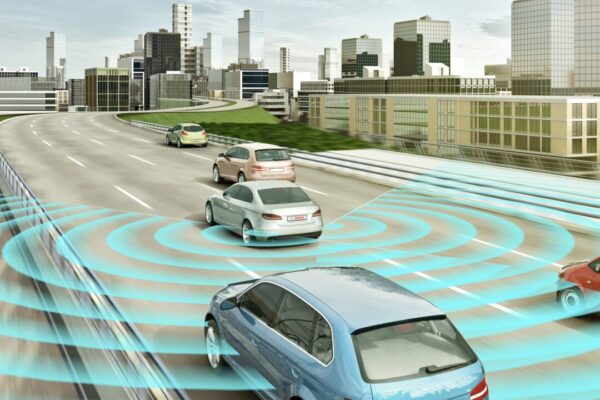
High-end vehicles can now speed down highways at up to 130 mph with minimal driver attention, said Lars Reger, chief technology officer of NXP’s automotive group based in Hamburg, Germany. Traffic laws are also evolving to reflect the possibility that self-driving cars can actually reduce the number of automotive fatalities.
Using sensor-laden vehicles, Google has already pre-scanned radar maps for routes a self-driving vehicle are likely to take, Reger explained. This enables self-driving vehicles to function as if they were on a track — not confronting a new pattern every time the car is driven, but rather tuning itself just to the unmapped variations. Since most highways have a common logic to their layout, up to 90% of a home-to-work journey could be pre-scanned. The last several kilometers may need intensified driver attention.
Automotive sensor hardware for self-driving cars follows similar topology as Internet of Things (IoT) hardware. A microcontroller effectively monitors how the car is performing, Reger said, and dispenses “driving advice.” This can get quite complicated: the Mercedes S-Class sedan, for example, has roughly 150 controllers. As a major microcontroller vendor, NXP stands to gain a great deal from proliferation of MCUs in future vehicles.
Much attention has been paid to increasing the processing power available to self-driving cars, with additional research focused on resolution of the sensing layer of the vehicle radar scanners. Automotive radar, which is now five to eight chips, can be reduced to two (in a 3mm x 3mm package) by changing the sensing architecture. Sensor resolution needs to be a few millimeters over a range of several hundred meters. This would be equivalent to sensing pebbles in roadway up a half mile ahead.
The connected car will impact not just roadway object detection, but how the car and driver communicate with their electronic environments. These communication pathways include Bluetooth, GSM telephony, Ethernet for high-speed communications in-car, and specialized user interfaces (such as Android Auto or Apple’s CarPlay. These communications interfaces will promote intelligent traffic management and help avoid accidents.
Taking Europe by storm
The simplest remote control systems, adaptive cruise control, will accelerate or decelerate car in response to road conditions and traffic. In more complex forms, they identify strange objects on the road ahead, and determine the appropriate response — weighing options such as braking, swerving, or lane changes. In Europe, the newest motorways help guide and control specially-equipped vehicles, almost as if they were hooked to a conveyor belt.
BMW, for example, promotes its 7 Series sedans as “partially autonomous.” It distinguishes between two different vehicle states, based on speed: highway driving (up to 130 mph) and city environments, where driver participation is more likely required (up to 43.5 mph). The “active highway” control system in the BMW sedan depends on a multitude of sensors (front, rear and side), and on clearly visible lane markers for its accuracy and intelligence. That’s where smart signs play a role: Using stereo cameras, the BMW can not only detect objects but it can also read what the road signs say. Heads up displays on the car can detect animals or pedestrians on the roadway 500 meters ahead.
The BMW sedan works entirely on its own to steer. Combined with object detection and adaptive cruise control, BMW claims its system eliminates the need for stiff attention by the driver, promoting what BWM calls a “relaxed journey.” Legally, however, the driver must maintain control of the vehicle — and the BWM sedan will warn drivers audibly whenever both hands are taken from the wheel. (At least one hand must touch the steering wheel to legally prove driver control.)
The ability to use road markers will vary from state to state in the U.S. as well as among different countries in Europe, Reger added. Highways must have the ability to identify themselves to the vehicle, to confirm to the vehicle which country or state it is in, and to automatically adjust the steering and speed controls to comply with the local regulations.
Putting smart cars in a smart city context
In the next 4-5 years, legislators must acknowledge that autonomous cars can actually be instrumental in preventing roadside fatalities. U.S. Transportation Secretary Anthony Foxx has been actively involved in the process of forming autonomous vehicle standards, according to Reger.
Expanding roles for RFID tags, include reading vehicles’ — and pedestrians’ — identities up to 20 meters away. School kids, for example, can be equipped their own individual RF IDs that could signal drivers when a school bus stops to load or unload. Smart city traffic lights could also be sequenced to facilitate their crossings, Reger said.
NXP is among the world’s largest suppliers of encryption devices, which enable smart cards for banking and transportation (e.g., bus and subway passes), and the company claims it supplies roughly 3/4 of the world’s passport chips. These tags could also enable vehicle identification.
In the next 4 to 5 years, a revolution in awareness needs to occur to support self-driving automobiles, Reger concluded. Judges and legislators need a new understanding of what the autonomous vehicle is capable of doing; vehicles need embedded identities to dictate how and where the vehicle would be utilized. Likewise, ambulance or emergency vehicles would need to use traffic lanes perhaps forbidden to other vehicles.
Steve Ohr is Semiconductor Industry Analyst. Article by courtesy of EETimes.com
Related articles:
Study: Autonomous driving changes cities and auto industry
Autonomous driving not a question of technology, managers say
What’s your definition of ‘autonomous’ car?
 If you enjoyed this article, you will like the following ones: don't miss them by subscribing to :
eeNews on Google News
If you enjoyed this article, you will like the following ones: don't miss them by subscribing to :
eeNews on Google News




